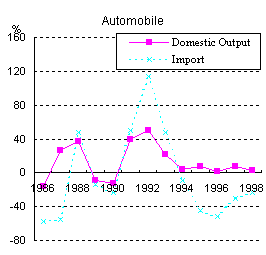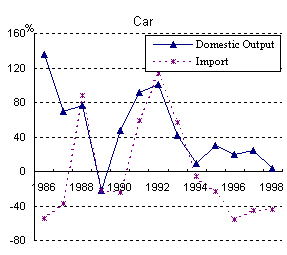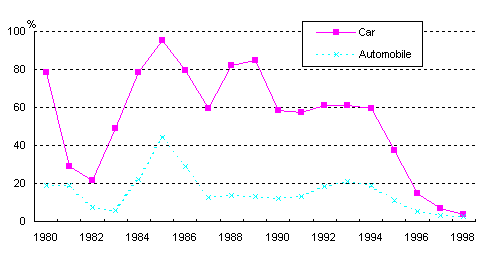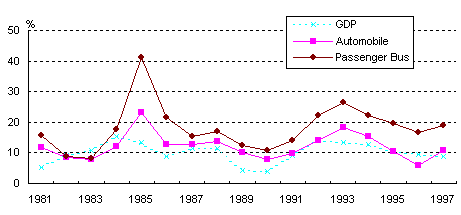Forecasts of Automobile Demand in China in the Coming 10 Years
Zhai Fan
Research Report No 122, 2000
The rapidly expanding domestic automobile market is a major advantage for the future development of China's automobile industry. It also attracts foreign automobile makers greatly. This paper is devoted mainly to the prospective automobile demand of China in the coming 10 years. The first section reviews the growth of the Chinese economy and the development of the Chinese automobile market in the past 20 years. Then the automobile demand of China in the coming 10 years is projected on the basis of a comparison of the numbers of automobiles in use in various countries (regions) during different stages of development.
I. Growth of China's automobile market (1978-1997)
Since 1978, the Chinese economy has grown at an average annual rate of 9.7 per cent. The rapid economic growth has greatly stimulated the development of transportation of various means and a growing demand for automobiles. Due to the lack of data of the annual sales of automobiles for those years, we have to ignore changes in automobile inventories and estimate the annual automobile consumption by adding up annual automobile outputs and imports and taking away annual automobile exports. The figures in Table 1 show that between 1980 and 1998, automobile consumption in China grew by an average annual rate of 10.4 per cent, with the rate of the growth of car consumption standing at 18 per cent.
In the recent 20 years, automobile demand in China has fluctuated extremely violently. Table 1 shows that in periods of expansion of automobile demand, annual growth rate usually rose above 30-40 per cent, with car demand being doubled and redoubled. In periods when the automobile market was sluggish, demand diminished tremendously. As luxurious consumer goods, cars would always outrun other kinds of automobile products in fluctuations. What calls for our attention is the fact that in recent years, the demand for cars has been growing fairly fast, with an average annual growth rate of 31 per cent in the 1990s. Although economic growth in China has been on the decline year after year since 1995 and the market demand has been fairly sluggish, the demand for cars has maintained a fairly rapid growth rate.
Table 1 Changes in Automobile Demand (1980-1998)
|
|
Automobile demand (10,000) |
Car demand (10,000) |
Growth rate % |
| ||
|
|
|
|
GDP |
Automobile demand |
Car demand | |
|
1980 |
27.3 |
2.5 |
|
|
| |
|
1981 |
21.7 |
0.5 |
5.3 |
-20.5 |
-80.7 | |
|
1982 |
21.2 |
0.5 |
9.0 |
-2.2 |
6.3 | |
|
1983 |
25.5 |
1.2 |
10.9 |
20.1 |
131.0 | |
|
1984 |
40.5 |
2.8 |
15.2 |
58.8 |
133.4 | |
|
1985 |
79.7 |
11.1 |
13.5 |
96.8 |
301.2 | |
|
1986 |
52.3 |
6.1 |
8.9 |
-34.4 |
-45.4 | |
|
1987 |
54.0 |
5.1 |
11.6 |
3.2 |
-15.1 | |
|
1988 |
71.9 |
7.0 |
11.3 |
33.3 |
35.8 | |
|
1989 |
63.9 |
5.3 |
4.1 |
-11.2 |
-23.7 | |
|
1990 |
54.6 |
5.8 |
3.8 |
-14.5 |
9.4 | |
|
1991 |
74.7 |
9.4 |
9.2 |
36.7 |
61.8 | |
|
1992 |
113.8 |
18.9 |
14.2 |
52.4 |
100.8 | |
|
1993 |
145.9 |
29.7 |
13.5 |
28.2 |
57.0 | |
|
1994 |
147.5 |
28.5 |
12.7 |
1.1 |
-4.0 | |
|
1995 |
144.4 |
34.5 |
10.5 |
-2.1 |
21.1 | |
|
1996 |
145.9 |
38.9 |
9.6 |
1.0 |
12.5 | |
|
1997 |
157.8 |
48.6 |
8.8 |
8.1 |
25.1 | |
|
1998 |
161.7 |
51.2 |
7.8 |
2.5 |
5.3 | |
Source: Estimated by the author according to 1998 Yearbook of China's Automobile Industry and Prospect of China's Automobile Market in 1999
Due to the gradual establishment of a market economy and the gradually enhanced role played by the market, fluctuations of automobile demand have led to fluctuations of automobile production and import in China. Figure 1 shows that compared with the changes in the volume of imported automobiles, automobile production fluctuates less violently, although it is also affected by the changes in market demand to a great extent. Automobile import, on the other hand, fluctuates feverishly with changes in market demand. Fluctuations in the automobile market demand are fully reflected directly in changes of imports. Between 1983 and 1985 when automobile demand swelled, for instance, imports of automobiles and cars both tripled or quadrupled every year. When the automobile market became sluggish between 1989 and 1990, annual import of automobiles stayed at merely 60,000 to 80,000, only one fifth of the peak figure in 1985. In 1992 and 1993, the annual import roared once again to 210,000 and 310,000 respectively.
Figure 1 Growth of Output and Import of Automobiles and Cars, 1980-1998


Since 1995, growth rate of automobile demand in China has been slow, and import of automobiles has declined constantly. But domestic output of automobiles, and that of cars in particular, have maintained a moderate speed of growth. Growing up gradually in recent years, the domestic automobile industry has improved its competitiveness to a certain extent. The continuous drop in automobile imports in recent years indicates the sluggish domestic demand on the one hand and on the other hand the competition by domestic automobile manufacturers. Figure 2 demonstrates that although automobile imports have fluctuated in the recent 20 years, the market penetration ratio of imported automobiles has diminished as a whole. This trend has become even more apparent in recent years. In 1998, the market penetration ratio of imported automobiles diminished from 18.5 per cent in 1992 to 2.5 per cent, and that of imported cars dropped from 61.1 per cent to 3.5 per cent. Although the proportion of imported automobiles may grow with the swelling of demand in the future, fundamental changes have taken place in the situation when imported cars dominated China’s car market. The position of imported automobiles in China's automobile market will be gradually weakened.
Figure 2 Changes of Market Penetration Ratio of Imported Automobiles, 1980-1998

II. Forecasts of automobiles in use (1998-2010)
From 1980 to 1997, the number of automobiles in use in China increased from 1.78 million to 12.19 million, with an average annual growth rate of 12 per cent. Average per-capita possession of automobiles rose from 1.4 per thousand people in 1978 to 9.9 per thousand people in 1997. Figure 3 shows that since 1980, the growth of the number of automobiles in use has a strong correlation with the economic growth in China and that the former has generally been slightly faster than the growth of GDP. The growth rate of buses in use, meanwhile, has been higher than that of automobiles as a whole.
Figure 3 Growth of Civil Automobiles in Use, 1981-1997

Development of possessions of automobiles in China has been similar with international experiences. The history of automobile development shows that the level of per-capita possession of automobiles and the change of this level in various countries are closely related to the respective stages of their economic development. At the initial stage of economic development, per-capita possession of automobiles will be fairly small, and the elasticity of automobile demand as against economic growth will be slightly higher than 1. At this stage, demand will focus mainly on trucks and buses. At the second stage, economic development will gain momentum, and automobile demand and the number of automobiles in use will grow. The elasticity of automobile demand will, however, basically remain unchanged or grow slightly. At the third stage, average per-capita income will reach a certain level after a period of high-speed growth, households will become the consumers of cars, average per-capita possession of automobiles will swell tremendously, and the elasticity will near or hit 3. When popularization of automobiles reaches a certain level at the third stage, the automobile market will be almost saturated and the elasticity of automobile demand will come close to 1.
...
If you need the full context, please leave a message on the website.














